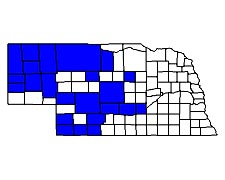Green Claybank Tiger Beetle |
|
|
|
| |
|
|
 |
 |
| Cicindela denverensis Casey |
| Adult Length: 12 to 16 mm |
| Appearance: Adults are green with somewhat variable maculation. Most individuals have a humeral and posthumeral dot, a slightly bent middle band, and apical and subapical dots on each elytron. Markings may be highly reduced and a few individuals have little more than an apical dot and a middle band reduced to a tiny slash-shaped mark. Heavily marked individuals may have the humeral and posthumeral dots fused, the apical and subapical dots fused, and a broad, well-developed middle band. |
| Similar Species: This species could be confused with C. sexguttata. Cicindela sexguttata is a much more brilliant green, and most Nebraska specimens have little or no maculation. In C. denverensis individuals with reduced maculation, the remnant of the middle band is slash-shaped, whereas the basal dot in the same location in C. sexguttata is rounded. |
| Biology: This species occurs on steep, bare slopes consisting of clay, loess, very fine sand, or loam. It can often be found in numbers on extensive road cuts. In much of Nebraska it co-occurs with C. splendida, and more rarely with C. limbalis. There is some evidence of possible hybridization with at least C. splendida in the vicinity of Kearney. In most other parts of the state there is no such evidence. Adults are often found on nearly vertical slopes, but will often occur on flatter areas nearby, such as gravel roads. |
| Adult Life History: Adults emerge from the pupa in August and September, but most adults apparently remain underground until late winter and spring. Activity resumes in March and April, with peak numbers in middle and late April. Numbers drop rapidly in May, and adults are usually rare by the third week of May. As in the other early spring species, numbers decline more slowly in the western part of the state, likely as a result of higher elevation. It is a spring-fall species. |
| Larval Life History: Eggs are laid mostly from late March to May. Most larvae reach the third instar by fall before overwintering. Activity resumes in spring and pupation occurs mostly in July. Larval burrows occur in steep slopes and the opening is perpendicular to the soil surface. The burrow curves toward vertical with depth. There may often be a pit downslope or even a circular cleared area around the opening. Larval burrows are usually no more than 40 cm in depth. |
| Biogeography: In Nebraska this species has been recorded as far east as Garfield and Buffalo Counties and is fairly common in proper habitat in areas to the west. It is interesting to note that the area of potential hybridization is at the eastern edge of its distribution in Nebraska. Further west it co-occurs with C. splendida with no evidence of possible hybridization. This potential hybridization may be nothing more than convergent phenotypes, but more research is needed to verify exactly what is occurring in these areas. In North America it occurs along the Front Range of the Rocky Mountains from southeastern Montana and northeastern New Mexico east to the central Great Plains states. |
|







